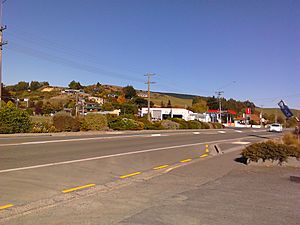Waihola facts for kids
Quick facts for kids
Waihola
Waihora (Māori)
|
|
|---|---|
|
Town
|
|

Main street of Waihola
|
|
| Country | New Zealand |
| Region | Otago |
| District | Clutha |
| Ward | Bruce |
| Electorates |
|
| Area | |
| • Total | 1.63 km2 (0.63 sq mi) |
| Population
(June 2023)
|
|
| • Total | 480 |
| • Density | 294/km2 (763/sq mi) |
| Urban PO Box Lobby Postcode (Waihola, Waihola) |
9243
|
| Rural Delivery Postcode (RD 1, Outram) |
9073
|
| International telephone access and area code | 03 |
| ISO 3166 code | 554 |
| Local iwi | Ngāi Tahu |
Waihola is a small town in Otago, located on New Zealand's South Island. It sits between the cities of Dunedin and Milton, New Zealand. The town is right next to the southeast shore of a shallow, tidal lake that shares its name.
Waihola is on State Highway 1, a main road in New Zealand. The South Island Main Trunk railway line also runs through the town, but trains do not stop there anymore. Waihola is part of the Clutha District.
Contents
What Does Waihola Mean?
The name Waihola is thought to come from the Māori words wai-hora. This means "spreading waters" or "wide waters". The New Zealand Geographic Board has officially given this name to the area.
It's interesting that the Māori alphabet usually does not have the letter 'L'. This suggests that 'Waihola' might be an example of an older way of speaking in the Southern Māori dialect.
People Living in Waihola
Waihola is considered a rural settlement. It covers about 1.63 square kilometers. As of June 2023, around 480 people live here.
The population of Waihola has been growing. In 2006, 276 people lived there. By 2018, the number had increased to 399 people. This was a jump of 123 people in 12 years.
Who Lives Here?
In 2018, there were 168 homes in Waihola. There were slightly more males (204) than females (198).
- About 19% of the people were under 15 years old.
- Around 9% were aged 15 to 29.
- Nearly half (49%) were aged 30 to 64.
- About 23% were 65 years or older.
Most people in Waihola are of European background (94%). About 10.5% identify as Māori. A small number are of Asian or other ethnic backgrounds.
When asked about religion, most people (60.2%) said they had no religion. About 31.6% were Christian.
Things to Do and See
Waihola is a popular spot for day trips, especially for people from Dunedin, which is about 35 kilometers north. The lake is a great place for many water sports. These include waterskiing, rowing, and yachting.
Waihola Waipori Wetlands
The Waihola Waipori wetland system is a very important natural area. It covers 2175 hectares, making it one of New Zealand's largest lowland wetlands. This wetland is home to many different plants and animals. It supports rare species like the giant kōkopu fish and the South Island Fernbird.
This wetland is very important to the local Kāi Tahu Māori people. They also use it for hunting and fishing.
Sinclair Wetlands
The Sinclair Wetlands are another important natural area located near Waihola.
Education
Waihola has its own school called Waihola District School. It is a state primary school for students from Year 1 to Year 8. The school first opened in 1859. As of February 2024, there are 27 students enrolled.
Images for kids




